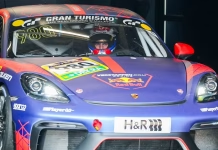The RUF CTR Yellowbird is one of the most iconic supercars in automotive history. This car is not just a marvel of engineering but also a symbol of innovation and performance. To understand the significance of the Yellowbird, we need to delve into the history of RUF and its transformation under Alois Ruf.
In 1974, Alois Ruf took over his father’s company, Ruf Auto. Initially, Ruf Auto was a successful bus-manufacturing business. However, young Alois had a different vision. He was passionate about sports cars, particularly the Porsche 911. By 1977, Ruf had built a reputation for enhancing the performance of the 930 Turbo.
One of the key innovations that set Ruf apart was the development of a five-speed gearbox in 1981, which was not available from Porsche at the time.
The turning point for Ruf came when German legislation recognized it as a manufacturer rather than just a tuner. This recognition allowed Ruf to innovate and produce cars under its own name. The RUF CTR, short for Group C Turbo Ruf, was born from this era of innovation.
The CTR, with its radical performance and distinctive yellow paint, quickly earned the nickname “Yellowbird”.
Design and Features
The RUF CTR Yellowbird’s design was a blend of subtlety and aggression. It featured a Carrera 3.2 shell, which was narrowed and devoid of rain gutters to reduce drag.
Aerodynamics played a crucial role in its design, with NACA ducts cut into the rear fiberglass fenders to feed air to the 3.4-liter flat-six biturbo engine. A single 935-style side mirror added to its aerodynamic efficiency.

Key Features of the Yellowbird:
- Engine: 3.4-liter flat-six biturbo
- Power: Officially rated at 469 hp, though many believe it was closer to 550 hp
- Top Speed: Over 211 mph
- 0-100 mph Time: 7.3 seconds
- Weight: Approximately 1,579 kg, giving it a superior power-to-weight ratio
The Yellowbird was not just about raw power; it was also about precision and control. The car’s suspension and chassis were meticulously tuned to handle the immense power. A roll cage added to the rigidity of the chassis, making the CTR a joy to drive at high speeds.
Impact and Comparison
In the late 1980s, the supercar landscape was dominated by names like Ferrari, Lamborghini, and Porsche. The RUF CTR Yellowbird, with its unassuming appearance, managed to outperform many of these established brands. It redefined what a supercar could be, blending the usability of a Porsche 911 with the performance of a race car.
The RUF CTR Yellowbird is more than just a car; it is a testament to innovation and engineering excellence. It challenged the norms of its time and set new benchmarks for performance and design.
Stefan Roser’s Legendary Lap
In 1989, Stefan Roser took the wheel of the RUF CTR Yellowbird for a lap around the Nürburgring, creating one of the most memorable moments in automotive history.
This lap was not only a testament to the car’s capabilities but also a showcase of Roser’s exceptional driving skills. The entire event was captured on video and later released as “Faszination on the Nürburgring,” becoming an instant classic among car enthusiasts.
The Nürburgring Lap
Stefan Roser, a RUF test driver, was chosen to demonstrate the full potential of the Yellowbird. The Nürburgring, often referred to as “The Green Hell,” is one of the most challenging and demanding racetracks in the world. Its 154 turns and 12.9-mile length require not only a powerful car but also immense skill and precision from the driver.
Roser’s lap was a masterclass in high-performance driving. The Yellowbird, with its 3.4-liter flat-six biturbo engine, roared through the track, showcasing its raw power and agility.
The car’s distinctive yellow paint flashed through the greenery of the Nürburgring, making it a visually striking event. What made this lap even more extraordinary was Roser’s ability to control the car through its extreme power surges and tricky handling characteristics.

Capturing History: “Faszination on the Nürburgring”
The decision to film the lap using on-board cameras was revolutionary for its time. This allowed viewers to experience the lap from Roser’s perspective, adding a new dimension to automotive videos.
The footage captured the raw sounds of the engine, the intense vibrations, and the sheer speed of the Yellowbird, making it a sensory experience unlike any other.
Filming Challenges:
- Technology of the Time: In the late 1980s, on-board camera technology was still in its infancy. Capturing high-quality footage in a high-speed, high-vibration environment like the Nürburgring required innovation and meticulous setup.
- Safety Concerns: Mounting cameras securely in a car that was expected to hit over 200 mph was a significant challenge. Ensuring that the cameras did not interfere with Roser’s driving or the car’s performance was paramount.
The resulting video, “Faszination on the Nürburgring,” was groundbreaking. It provided an unprecedented view into high-performance driving and car control.

The video quickly became a hit among car enthusiasts, setting a new standard for automotive videos. It not only showcased the Yellowbird’s capabilities but also highlighted the Nürburgring as the ultimate proving ground for supercars.
Quotes from Experts:
-
Jeremy Clarkson, renowned automotive journalist, said, “Watching the Yellowbird dance around the Nürburgring was like watching a master painter at work. It was pure artistry on four wheels.”
-
Alois Ruf, reflecting on the video, remarked, “The ‘Faszination’ video showed the world what the CTR was truly capable of. It was a moment of pride for our entire team.”
The combination of Roser’s driving skill, the Yellowbird’s engineering excellence, and the innovative use of on-board cameras created a legacy that continues to inspire and captivate enthusiasts around the world.
See you on the track!
This website uses affiliate links which may earn a commission at no additional cost to you.









![iRacing: Best Apps for Planning Your Season 1 [2026]](https://i0.wp.com/boxthislap.org/app/uploads/2021/02/sim-10.webp?resize=100%2C70&ssl=1)
![iRacing: Ultimate Buyers Guide for Season 1 [2026] ir road Atlanta 2025](https://i0.wp.com/boxthislap.org/app/uploads/2025/12/ir-road-Atlanta-2025.webp?resize=100%2C70&ssl=1)
